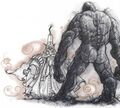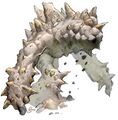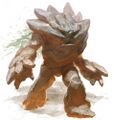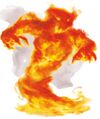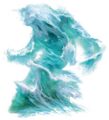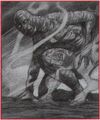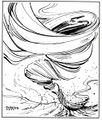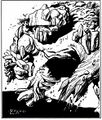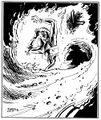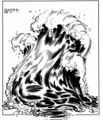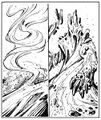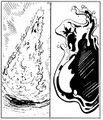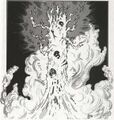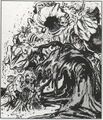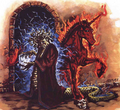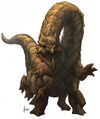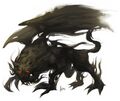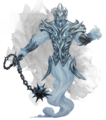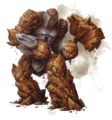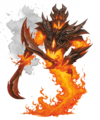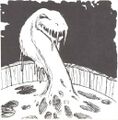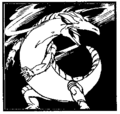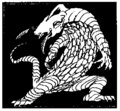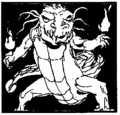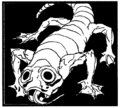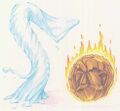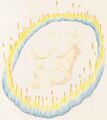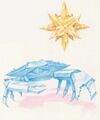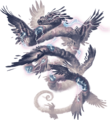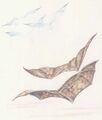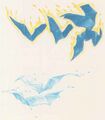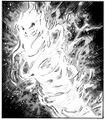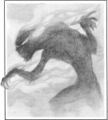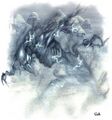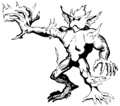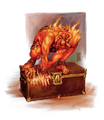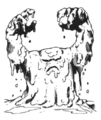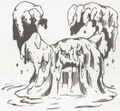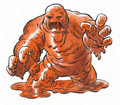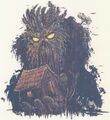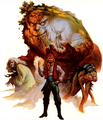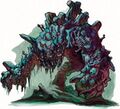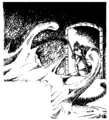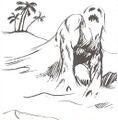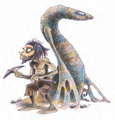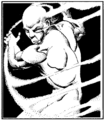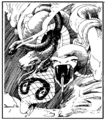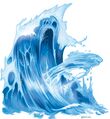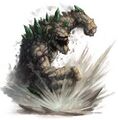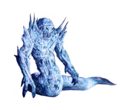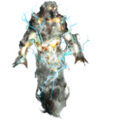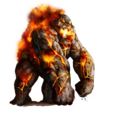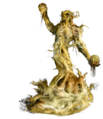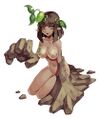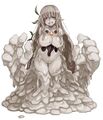Elemental
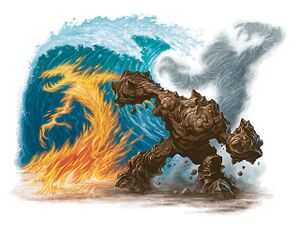
An Elemental is a nebulous breed of monster defined by its strong connection to the power of the Elements. The most iconic depiction of the elemental is as the incarnate spirit of a given element, causing it to manifest as a (usually roughly humanoid) entity comprised solely of elemental matter - a swirling mass of wind or flame, a mobile clump of earth or a slime-like animate puddle of water. However, many different monsters have been considered "elementals" over the years.
A Pixar movie about them is in the works.
Real-World
As a basic concept meaning "magical being that embodies or personifies a force of nature", the elemental has been around a very long time. The idea is practically universal, and has its roots in everything from gods and nymphs to more modernistic "fairy tale" beings like Jack Frost.
The most well-known real-world belief about elementals, and probably that which has had the greatest impact on fantasy gaming, is that created by the 16th century alchemist Paracelsus, who defined four main "races" of elemental - Gnomes of Earth, Salamanders of Fire, Sylphs of Air and Undines of Water - as part of his personal alchemical philosophy, because it wasn't until a few centuries ago that folks realized that just making shit up isn't good science. Other prominent alchemists with similar theories include Heinrich Cornelius Agrippa and the Comte de Gabalis, whilst elementals were integral in the belief system of the Rosicrucians.
Dungeons & Dragons
In Dungeons & Dragons, elementals are Outsiders (meaning they're not native to the Prime Material) native to the Elemental Planes, and thus take the form of roughly humanoid creatures made up of elemental (or paraelemental, or quasielemental) matter. This has led to a vast and sprawling family of elementals and elemental-like creatures over the various editions, starting with Advanced Dungeons & Dragons.
Your standard Elementals are, well, as described; vaguely humanoid masses of elemental matter. They are the most populous of the various elemental beings. The less popular Paraelementals and Quasielementals showed up in AD&D. Basically if you can think of a combination of energy types there should be an elemental for that.
-
Air 1e
-
Earth 1e
-
Fire 1e
-
Water 1e
-
Air & Earth 2e
-
Fire & Water 2e
-
Air 2e
-
Earth 2e
-
Fire 2e
-
Water 2e
-
Earth 3e
-
4e
-
Air 5e
-
Earth 5e
-
Fire 5e
-
Water 5e
- Paraelementals and Quasielementals
-
Ice
-
Lightning
-
Magma
-
Ooze
-
Smoke 1e
-
Smoke 2e
World Axis
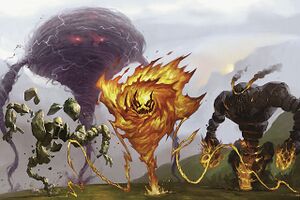
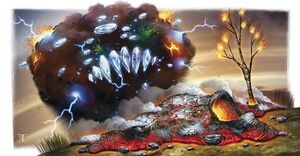
4e's World Axis houses the standard elementals and genies, but also does something a little more unique: it is home to multiple kinds of "mixed" or "hybrid" elementals, rather than a small selection of paraelementals and quasielementals. These can range from things like a geode octopus to a hybrid ice/magma hulk to the Primordial Blot; a mixture of all known kinds of elemental matter/energy that is theorized to be a stillborn and/or fetal planet. It's also home to blight-born demons, a kind of fiend created from elementals corrupted into demons by exposure to the energies of the Abyss. Some of the more distinctive blight-born are dust demons, which are whole families of djinn transformed into a singular entity that takes the form of a writhing whirlwind of dirt, dust, teeth and broken bones, and ash-wrought soulburners, which are efreeti who have had the vital spark sucked out of them, turning them into fire-resistant, cold-vulnerable heat vampires.
Dark Sun
Dark Sun added a bunch of elemental variants, since Athas has no gods so clerics are recast as elemental mages in that setting. It also used the alternative paraelementals of rain, silt, and sun instead of ice, ooze, and ash, respectively.
Greater/Lesser Elementals
-
Greater Air
-
Greater Earth
-
Greater Fire
-
Greater Water
-
Lesser Air and Earth
-
Lesser Fire and Water
Elemental Beasts
-
Air
-
Earth
-
Fire
-
Water
-
Magma
-
Rain
-
Silt
-
Sun
Elemental Kin
AD&D introduced the concept of "Elemental Kin"; entities that were very strongly related to the elementals, but looked and functioned more like humanoid races rather than spirits possessing matter. Air was home to Sylphs; Earth was home to Pech; Fire was home to Azers and Salamanders; Water was home to Nereids.
Genie
Genies in D&D are considered a breed of elemental, if very distinct from the standard masses. This is why there are four distinct breeds, one for each element; Dao of Earth, Djinn of Air, Efreet of Fire and Marid of Water. Plus the fifth "mixed elemental" Jann.
Genasi
Planetouched with an elemental heritage are called Genasi, and debuted in the Complete Planeswalker's Handbook for Planescape back in the 1990s. Weirdly, they went on to become particularly associated with the Forgotten Realms afterwards, to the point their PC writeups for both 3rd and 4th edition were in Realms splatbooks.
Dread Elemental (Ravenloft)
These are standard Earth, Air, Water and Fire Elementals that were summoned into Ravenloft, and were warped into horrible versions of themselves. Grave Elementals are warped Earth Elementals that are made of grave soil and have the ability to bury people alive with a touch. Mist Elementals are corrupted air elementals who have the ability to turn people Chaotic Evil with a touch. Blood Elementals are tainted Water Elementals who can drain the blood from others to feed themselves. Pyre Elementals are distorted Fire Elementals who have the ability to either burn through armor (AD&D) or animate corpses as burning zombies or skeletons (3e).
Fan-made Dread Elemental-Kin appeared in the Book of Shadows netbook; Myst Sylphs, Mist Servants, Crypt Gnomes (corrupted Pech), Gravelings, Heat Stalkers (corrupted Salamanders), Pyre Wyrms (corrupted "Fire Snakes" - larval Salamanders), Bloody Marys (corrupted Nereids) and Scarlet Streams (corrupted AD&D Water Weirds).
-
Pyre and Mist
-
Blood and Grave
-
Blood
-
All four
Others
Animental
A creature from AD&D that was updated to 3.5e as a template in Dragon Magazine #347. An animental is an animal or monster (including monstrous humanoids, like medusas) who died and whose spirit was drawn into an Elemental Plane, where it was reincarnated as an elemental version of its former self. This idea probably inspired the Elemental Template in 3rd edition.
-
Magma rhinoceros
Archomental
The powerful demigod-like rulers of the Elemental Planes.
Elemental Archon/Myrmidon
Introduced in 4e, these are the former soldiers in the armies of the Primordials in the Dawn War, After the gods defeated the Primordials the Archons fell to the service of various elemental lords, both petty and great. They still retain their desire to return their masters to their rightful place in the world and would potentially betray everyone they work for to see this done.
5e refluffed them into the more generic Elemental Myrmidons, making them a neutral allied creature that can be made by conjuring an elemental into a suit of armor.
-
Earth
-
Fire
-
Ice
-
Water
-
Lightning
-
5e Air
-
5e Earth
-
5e Fire
-
5e Water
Crysmal
Crysmals are psionic earth elementals made of crystals that look kind of like crab-scorpions. They stand about 3 and a half feet high.
Elemental Weird
Introduced in AD&D, these were originally portrayed as serpentine Elemental Kin, with only Earth Weirds and Water Weirds existing, but in 3rd edition these were changed into their own unique Nymph-like elemental Oracles, with one for each plane. The original Elemental Weird became the Lesser Elemental Weird, a larval state, and didn't get acknowledged until Dragon Magazine #347.
-
1e
-
2e
-
Earth Weird
-
Now in Color!
-
3e Air & Water
-
3e Earth & Fire
-
5e
Elemental Vermin
Introduced in Al-Qadim, these are small animals native to the four Elemental Planes and which basically serve as their home environment's form of pest. They consist of the armadillo-like Duster (Air), koboldish rat-dog-lizard Crawler (earth), alligator hatchling-like Flameling (fire) and tailed toad-like Spitter (water). Theoretically, they could serve as familiars.
-
Duster (Air)
-
Crawler (Earth)
-
Flameling (Fire)
-
Spitter (Water)
Elemental of Chaos & Law
Mystara has Elementals of Chaos and Elementals of Law, who seek to further the cause of their respective alignments on the elemental planes.
-
Eolian (Air Chaos) and Erdeen (Earth Chaos)
-
Pyrophor (Fire Chaos) and Undine (Water Chaos)
-
Anemo (Air Law) and Kryst (Earth Law)
-
Helion (Fire Law) and Hydrax (Water Law)
Elder Elemental
Intruduced in 5e's Mordenkainen's Tome of Foes and composed entirely of retconned monsters from previous editions, these elementals are apocalyptic forces of nature capable of razing entire cities to dust.
The four elder elementals are: Leviathans, massive serpents made of water capable of creating tidal waves; Phoenixes, birds of fire that explode upon death and actively seek to spread fire and destruction; Elder Tempests, feathered winged serpents with the power of a thunderstorm; and Zaratans, turtles of earth that will probably crush your entire village underfoot without even realizing it.
-
Elder Tempest
-
Zaratan
-
Phoenix
-
Leviathan
Fundamental
Weird elemental creatures from AD&D that look like a pair of bat wings with no body between them.
-
Air and Earth
-
Fire and Water
-
All four
Firetail
Fire elementals with ADHD. They will often forget what they're doing and run off somewhere else, completely ignoring their allies. They communicate by changing the color of their flames. Firetails with spellcasting abilities are called tshala.
Fogwarden
A wraith-like being composed of fog, ice and lightning that inhabits cold climates. It feeds off strong emotions, especially fear. Feeding isn't hard at all because it has a 30 foot aura of fear. Any metal weapon that touches it must make a saving throw (items can make saving throws?) or be instantly destroyed. On top of this, it also animates all dead bodies in a 15 foot radius as minions, and these zombies don't count as undead and thus can't be turned.
Grue
Small, malevolent, elemental spirits, with one for each of the four Elemental Planes.
Magmin
Magmen, renamed Magmins in 3e, are impish magma paraelementals who loving setting things on fire.
Mephit
Small, weak, obnoxious elemental imps.
Mihstu
Air elementals that can extend up to 4 talon-tipped tentacles from their misty bodies. Haven't been seen since 1e.
Mudman
Mudmen are, oddly, not an elemental from the Plane of Ooze, but are spontaneously formed from mud that has a high concentration of magic. They appeared in 1e, 2e, and 4e in Dungeon Magazine #214, where their lore was changed so that they actually are elementals.
Mudtiger
Ooze paraelementals created by Skip Williams for his prequel module A0 that appeared in WotC's 2013 re-release of Scourge of the Slave Lords. Their biggest surprise is an AoE electric attack that magnetizes metal weapons and armor.
Nature Elemental
Debuting in the Ruins of Zhentil Keep boxed set, the nature elemental is made out of all four elements plus the "fifth element" of spirit or life. It looks like a really big earth elemental covered in vegetation, with small animals crawling around on it. It is very hard to kill because it regenerates back to full health every round.
The nature elemental has a big influence on its immediate environment: Plants grow to maturity almost instantly; animals are attracted to it; Water is purified; and all signs of civilization disappear.
Necromental
The 3.5e book Libris Mortis introduced undead elementals, which it calls necromentals.
-
Earth Necromental
Sandling
Sandlings are amorphous masses of moving sand from the plane of Earth. They reproduce by budding. They don't like water, as getting sufficiently wet makes them slower and weaker.
Sandman
Unlike sandlings, Sandmen are humanoid. Most of them are enslaved by Dao, and are sent the the Prime to capture more slaves.
Spirit of the Air
Divine servants of gods who control air and wind. They look like monkeys with bat wings for hands.
Vortex
From the Plane of Air. A floating sphere the size of a baseball that creates whirlwinds by flying around rapidly.
Wind Walker
Two different air elementals called Wind Walkers have appeared in D&D. The first is a humanoid with two pairs of wings and a snakelike lower body that appeared in the 4th set of AD&D 1e Monster Cards. The other is a floating heap of serpents and appeared in the 2e Al-Qadim adventure Assassin Mountain.
Pathfinder
All OGL elementals are maintained from 3.5. The elemental type no longer exists, instead being a subtype of Outsider that carries most of the rules baggage of the original type. Mostly this just frees the writers from having to saying "outsiders and elementals" a bunch since most effects that worked on one worked on both. Pathfinder has since added further elemental types.
Aether Elementals are beings made of translucent, multicolor threads that embody Aether, the "element" that contains magical force and telekinesis. They can be invisible whenever they want. Small ones make for some of the best familiars in the game since they're invisible and their telekinetic abilities scale based on their master's hit die.
Paraelementals were eventually stolen from D&D, with new statistics since they weren't OGL. Since they weren't OGL they're also never actually referred to as "paraelemental" in published material, but no alternate name has been printed, so everyone outside of Paizo still calls them that. While Ice (Water+Air) and Magma (Earth+Fire) were natural enough combos to copy outright, Mud (earth+water) replaced ooze. Smoke elementals, oddly enough, don't exist even though an Elementalist Wizard sub-school for the combination does. Pathfinder also has the oddball of Lightning Elementals. Formed of giant thunderstorms on the elemental plane of air. Even more simple minded and aggressive than typical elementals. None of these are particularly exceptional as a familiar.
-
Water
-
Fire
-
Earth
-
Air
-
Ice
-
Lightning
-
Magma
-
Mud
-
Sandstorm
Battletech
In BattleTech, Elementals are the genetically engineered infantry of the Clans, bred over dozens of generations to operate Clan Battle Armor. They are the largest and strongest of the three trueborn phenotypes; with the others being Pilots and MechWarriors.
Monstergirls
As with every other kind of monster, elementals sometimes get the monstergirls treatment too. It helps that because of how generic the term is, any woman with the right elementalism powers and coloration could easily be passed off as an elemental monstergirl. It doesn't hurt that Dungeons & Dragons also introduced the Genasi race, who're supposed to descend from unions of humans and elementals, so technically a monstrous woman version of an elemental is canon in D&D.
It helps that it literally comes with the standard portrayal of an elemental - a creature influenced by its elemental symbolism - and all it's really doing is putty a sexy skin over a standard concept.
In the Monster Girl Encyclopedia, the term "Elemental" is used to cover various elemental spirits - some with a rather tenuous connection. For example, the Kitsune-bi is considered an elemental.
Naturally, the core four are well represented. Gnomes are earth elementals who take the form of curvaceous women made out of living earth and stone. They are calm, gentle creatures whose presence enriches the land around them, making it healthy and strong, and giving them an affinity for plant mamono. Sylphs are playful, free-spirited, green-skinned & haired sylvan spirits who serve the setting as air elementals. Undines are water elementals whose bodies are technically slime-like, being comprised of animated water, but which can assume a solid human-like thickness to better interact with humans; calm-natured and devoted, they are a gentle race. Finally, the role of fire elementals is filled not by Salamanders - in this setting a kind of lizardfolk - but by creatures called Ignises, hotheaded, fiery-tempered and passionate spirits who appear as naked human women with flame swirling around their bodies and preserving their modesty.
Then... there are the other elementals. Dark Elementals are embodiments of the dark, demonic energies that the Demon Queen is using to transform the world into her infernal paradise; their very presence can transform whole villages into dens of monstergirls. For reasons known only to the author, whilst the other elementals have more inhuman forms, Dark Elementals appear as naked lolis floating atop a ball of inky-black slime. Yuki-Onnas are considered "Ice Elementals", but that role is more directly filled by Glacies and their Ice Queen rulers; crystaline-aspected and coldly beautiful women of pale-blue flesh and icy shells who seek to steal the metaphysical warmth from humans for themselves. Finally, the Dorome is a dopey lustful slime-like elemental of living mud, apparently created by accident when too much demonic energy and wet soul goes into the process of embodying a gnome - the wording is highly awkward and difficult to understand.
-
Earth
-
Wind
-
Fire
-
Water
-
Ice
-
More Ice
-
Mud
| The inhabitants of the Planes of Planescape | |
|---|---|
| Upper Planes | Aasimon • Angel • Animal Lord • Archon • Asura • Eladrin • Guardinals • Lillend |
| Middle Planes | Formians • Githzerai • Inevitable • Marut • Modron • Rilmani • Slaadi • Kamerel |
| Lower Planes | Alu-Fiend • Baatezu • Bladeling • Cambion • Demodand • Erinyes • Hag • Hordling • Imp • Kyton • Loumara • Marilith • Obyrith • Succubus • Tanar'ri • Yugoloth |
| Transitive Planes | Astral Dreadnought • Githyanki |
| Inner Planes | Azer • Elemental • Genie • Grue • Mephit • Salamander • Sylph |
| Sigil | Dabus • Cranium Rat |
| High-ups | Archangel • Archdevil • Archfey • Archomental • Demon Prince |











